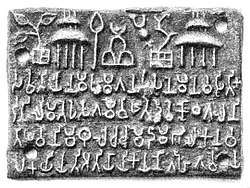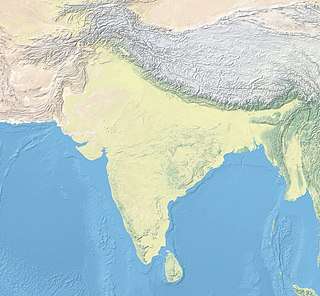Sohgaura copper plate inscription
| Sohgaura copper plate inscription | |
|---|---|
 The Sohgaura copper plate. | |
| Material | Copper plate |
| Writing | Brahmi script |
| Created | 3rd century BCE |
| Period/culture | 3rd Century BCE |
| Discovered | 26°34′N 83°29′E / 26.57°N 83.48°ECoordinates: 26°34′N 83°29′E / 26.57°N 83.48°E |
| Place | India |
| Present location | Sohgaura |
 Sohgaura | |
The Sohgaura copper plate inscription is an Indian copper plate inscription written in Prakrit in the Brahmi script. It was discovered in Soghaura, a village on the banks of the Rapti River, about 20km south-east of Gorakhpur, in the Gorakhpur District, Uttar Pradesh, India.[1]
The plate, consisting of a line of symbolic drawings and four lines of text, is the result of a molding.[2] The inscription is sometimes presented as pre-Ashokan, even pre-Mauryan, but the writing of the plate, especially the configuration of akshara would rather suggest a date after Ashoka.[2] Nowadays, this plate is generally considered to be from the Maurya period, and seems to be part of the larger set of inscriptions (the Edicts of Ashoka), written by Ashoka through India.[3]
The text of the plate has been translated as follows. Its mentions the establishment of two grain depots (Kosthagara) to fight against famine.[4]
Sāvatiyānam Mahāma(ttā)nam sāsane Mānavāsītika-
ḍasilimate Ussagāme va ete duve koṭṭhāgālāni
tina-yavāni maṃthulloca-chammā-dāma-bhālakān(i)va
laṃ kayiyati atiyāyikāya no gahi(ta)vvāya[5]At the junction called Manawasi,
these two storehouses are prepared,
for the sheltering of loads of commodities,
of Tiyavani, Mathura and Chanchu.— Translated by Fleet[2]
This is the oldest Indian copper plate inscriptions known.[3][4]
See also
References
- ↑ THE SOHGAURA COPPER-PLATE REGISTRATION BM Barua Annals of the Bhandarkar Oriental Research Institute Vol. 11, No. 1 (1930), pp. 32-48
- 1 2 3 Sircar 1942 Select Inscriptions Vol 1 OCR p.85
- 1 2 The Archeology of Early Historic South Asia: The Emergence of Cities and States by FR Allchin, George Erdosy p.212
- 1 2 2000+ MCQs with Explanatory Notes For HISTORY by Disha Experts p.63
- ↑ Barua, B. M. (1930). THE SOHGAURA COPPER-PLATE INSCRIPTION. p. 48.
